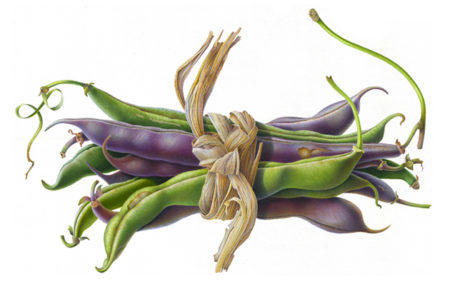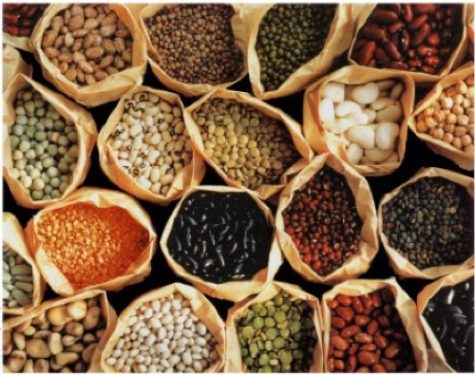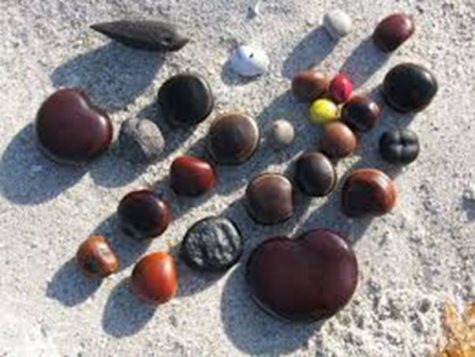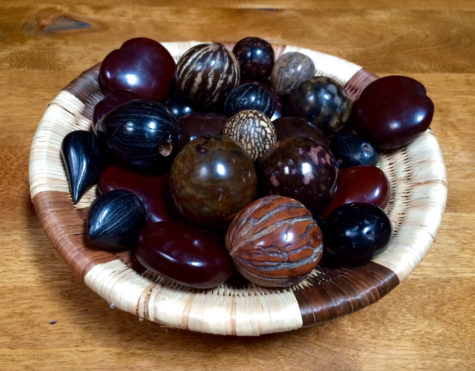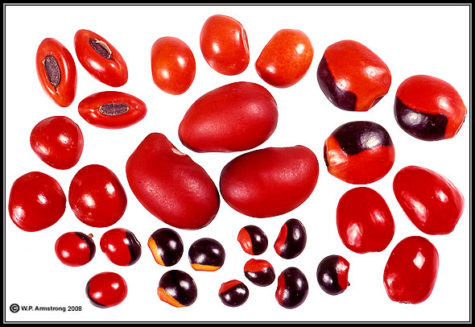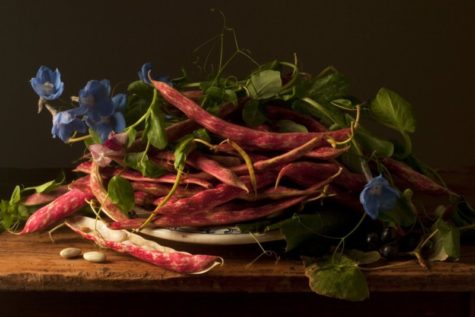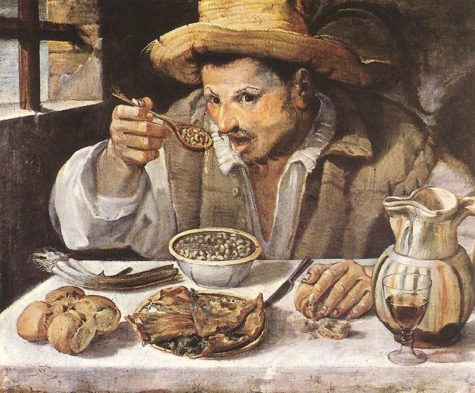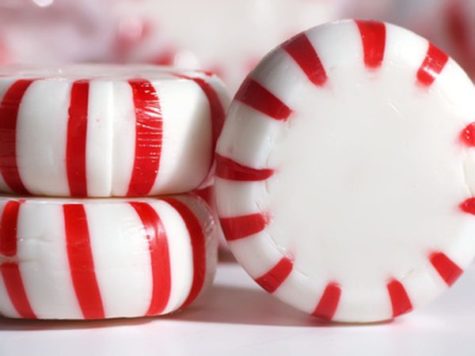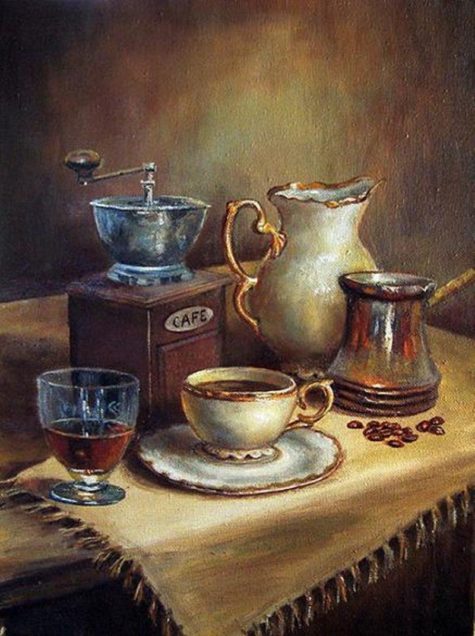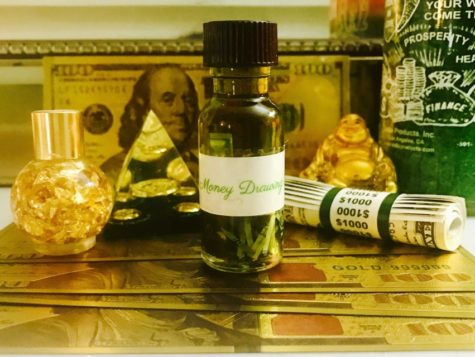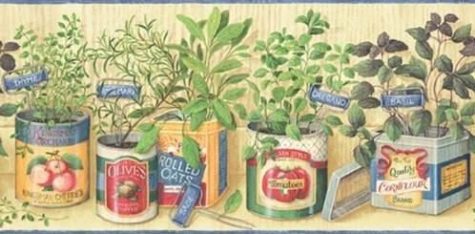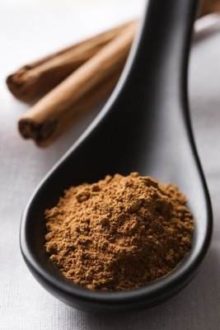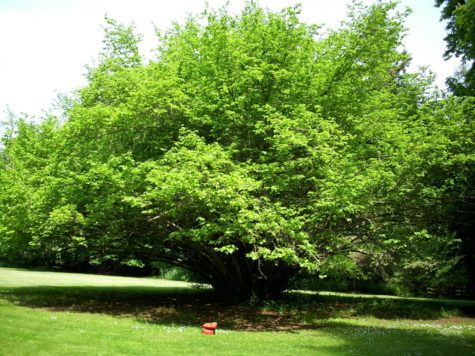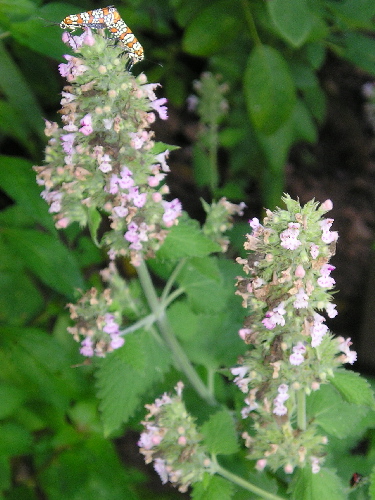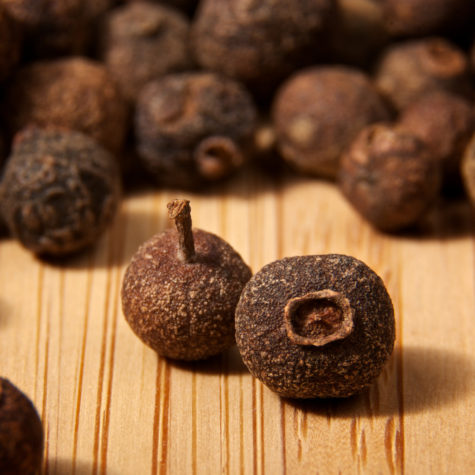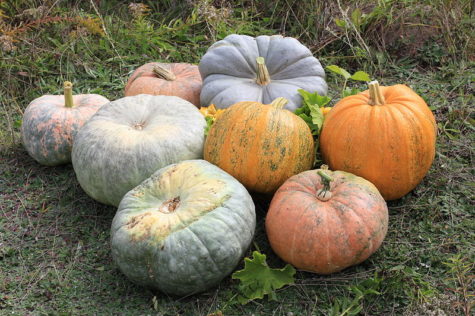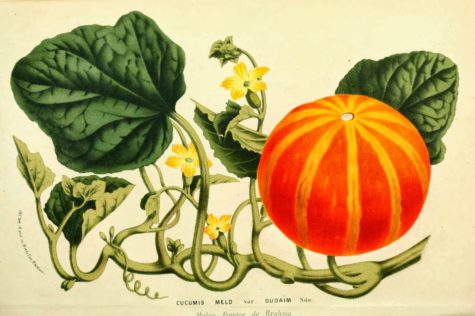Good Luck
Many legumes have seeds, called peas or beans, that are lucky. There are also pasture and tree legumes whose leaves and seeds are carried for luck. There is quite a lot of magick and lore surrounding these little packages of energy.
- Ruler: Mercury
- Type: Vegetable, seed
- Magickal form: dried, raw, cooked
Use beans to appease the spirits of the dead. Throw some around the outside of the home if a ghost or poltergeist is bothering you. Beans inspire creativity and communication and can be carried raw in a pouch or cooked and eaten for inspiration.
Here is a list of the different types of beans and their specific properties:
- Black turtle beans help to jump hurdles and make important decisions.
- Butter beans reduce stress.
- Canary beans bring happiness and success in the arts.
- Cow or black-eyed peas bring luck and increase psychic vision.
- Cranberry (October) beans attract new opportunities.
- Fava beans bring power, and make wishes come true.
- Garbanzos (chickpeas) help beat the competition.
- Great northern beans bring discovery and insight; they also help to protect plans and keep them secret.
- Green baby lima beans bring new income.
- Green split peas are for money or health.
- Green pigeon beans represent resourcefulness and money.
- Large lima beans allow expansion and financial growth.
- Lentils bring peace and financial security.
- Navy beans increase strength and determination.
- Oval white beans protect assets.
- Pink beans bring confidence and romance.
- Pinto beans open channels and create action and movement.
- Red kidney beans represent wisdom, love, and healing.
- Roman beans bring power and precision.
- Small red beans provide energy and lust.
- Speckled lima beans create networking opportunities.
- Tonka beans help in romance, often found in love-drawing mojo hands.
- Whole green beans attract money.
- Yellow split peas bring luck and fame.
Two legumes are widely utilized in rituals to cause wishes to come true. The Fava bean is for general good luck wishes, and the Tonka bean is for love-drawing wishes.
Sea Beans
Exotic to the eye, drift seeds, or “sea–beans” are actually seeds from common trees and vines that grow in the tropics. The beans fall from the parent plant, into streams and rivers, to drift with the ocean’s currents until being washed onto a shore thousands of miles from where they once grew. Floating in the sea by the thousands, only the hardiest endure long voyages on ocean currents which may finally bring them to rest on foreign shores. Sea–beans are known as symbols of good luck and longevity.
Sea beans can include the following:
- Sea Hearts
Heart shaped beans such as Entada gigas found on northern Atlantic shores, and Entada phaseoloides and rheedii from the southern Pacific. Sea Hearts are produced in huge, hanging bean pods, up to six feet long. Sometimes they are found with imprints and lacerations, caused by the teeth of fish and mammals during their voyage. They are impervious to salt water, even after floating in the ocean for several years.
These beans have been fashioned into all sorts of trinkets and useful objects. Sailors carried sea hearts as good luck charms to protect them from sickness and to ward off the evil eye. Seeds were sometimes cut in half, the contents removed and the woody seed coats hinged together. Hollowed out seeds were commonly used in Norway and Northern Europe for snuff boxes, match boxes and lockets.
It is said that a sea heart (also known as fava de Colom) inspired Christopher Columbus to set out in search of lands to the west.
- Sea Purses
Purse shaped beans such as Dioclea sp. found on Atlantic beaches, and the elusive Australian Dioclea hexandra. Coveted by collectors, Sea Purses and Saddle Beans (Dioclea sp.) are one of the rarest and most colorful of all sea beans found on any beach. Distinct color variations range from butterscotch to solid black.
It was originally grown in Asia, but has drifted to islands in the Caribbean and Central and South America, reproducing there. They are found growing on the Hawaiian Islands where they may have also drifted or, like so many other species, introduced by people.
- Hamburger Beans
Such as Mucuna sloaneii, urens, and elliptica along with a few south Pacific natives, Mucuna gigantea and membranacea, so called because they look a lot like this popular sandwich.
Seeds from the Mucuna vine are called Hamburger Beans or True Sea-Beans in the United States. In Mexico, they are known as Ojo de Venado or Deer’s Eye. There are hundreds of varieties growing in tropical regions around the globe. They can be brown, red or brindle shades of red and brown.
These beans are members of the pea and bean family that contain toxic, hallucinogenic or medicinal alkaloids and therefore figure in good luck charms.
In the case of the Mucuna bean, the mature beans are considered both aphrodisiac and very protective in Mexico and Central America against the evil eye. Nowadays they are carried for good luck.
- Vine Seeds
Every collector’s favorite, the Mary’s Bean (Merremia discoidesperma) is a rare find among drift material anywhere in the world and highly prized by drift seed collectors. Named after the Virgin Mary, it is also called the crucifixion bean because of a cross etched on one side of the seed, leading to it being used as a talisman and many superstitions and legends are connected with it.
A woman in labor was assured an easy delivery if she clenched a Mary’s bean in her hand, and the seeds were handed down from mother to daughter as treasured keepsakes. In northern Europe the Mary’s bean was a special find to pious beach-combers. The seed had obviously survived the ocean and they felt it would extend its protection to anyone lucky enough to own one.
In addition to its unique appearance, it holds the record for the longest recorded drift: 15,000 miles., along with some Caribbean Little Marbles and Florida native Bay Beans.
Bay beans (Canavalia rosea) are one of the most common and plentiful of all sea-beans growing abundantly in dunes worldwide. The vines and their pods grow low along the sand and are easy to spot on the berm with long flower-studded runners. These vines protect the dunes by stabilizing the sand along with other plants. The coloration of the beans vary from mottled and swirly browns to different shades of beige.
Little Marbles (Oxyrhynchus trinervius), also known as Black Pearls, are plentiful in Nicaragua, Costa Rica and Panama. The parent plant is an aggressive climber in the right conditions. A rare find on North American beaches, as they are not good floaters and few get very far from their parent plant.
- Shrub Seeds
Shrubs that produce these beans are some of the most resilient plants found. They came from parents growing in inhospitable conditions such as drainage ditches, along barbed-wire fencing and embedded in hard-pack soil with drainage that would kill anything else.
Recurved spines growing on their branches protect the precious seeds from animals that probably shouldn’t be eating them. They include Coral Beans (Erythrina sp) and Grey Nickars (Caesalpinia bonduc) and the less aggressive Brown Nickar (Caesalpinia major).
Grey nickars (aka Sea Pearls) found on east coast beaches of Florida may have washed in from the Gulf Stream or are from plants growing locally. The name nicker comes from an old English word meaning marble. Nickernuts are used for playing pieces in board games the world over.
Far less common than Grey Nickarbeans, and a bit larger, the Brown Nickar comes from similar plants, but have the color of light milk chocolate.
- Tree Seeds
All trees produce seeds, but not all are considered beans, much less sea-beans. More often the seed pods have flotation abilities, though short as they are since salt water starts to break them down as soon as they get wet.
Guanacaste (Enterolobium cyclocarpum), one of the most beautiful beans of the New World tropics comes from a huge canopy tree. It is a fast growing species and one of the largest trees found in Central America.
The word Guanacaste, which is also the name of the Costa Rican province of Guanacaste, is of Nahuatl origin and means “ear tree.” The coiled, leathery pods resemble the shape of a human ear. Guanacaste seeds have a distinctive brown “eye” and make some of the most striking seed jewelry.
Makha-Mong (Afzelia xylocarpa). This tree grows in Thailand, Vietnam, Cambodia, Laos and Burma in deciduous forests. In Southeast Asia, the seeds are harvested for medicinal purposes. The seed pulp can be used to make cigarettes, and the bark and seed are used for herbal medicine.
Laurelwood (Calophyllum calaba), also known as santa-maría or false-mamey, this medium-sized tropical evergreen tree is frequently used for reforestation, as a shade tree or a protective hedge. The seeds are perfectly round and coloring runs from light beige to dark brown. At certain times of the year, they can be plentiful on beaches, looking like small ping-pong balls. Polishing brings out their natural coloring.
Royal Poinciana (Delonix regia). In the Caribbean, the pods from these trees are used for fuel and called “woman’s tongue” for the rattling noise they make when the wind blows them. The empty pods are classified as sea-beans but only have a maximum flotation of about a month. The seeds are gathered from pods and fashioned into jewelry around the world.
Large brown beans
Some large brown beans are tropical species that accidentally get distributed worldwide because their pods float. Swept downstream, they make their way to the ocean before the pods fall apart, and when these “Sea Beans” wash up in Northern climes, they are carried as lucky pocket pieces.
Other large brown beans are cultivated as fodder. Their seeds are often mildly toxic, containing DMT compounds or L-dopa, but some find use in local medicine as vermifuges. Most are carried as amulets.
One exception to the “large brown beans are toxic” rule is the greenish-brown Fava bean, which is cultivated for use as a food despite the fact that some people are highly allergic to it. Fava beans are also known as Mojo Beans, or African Wishing Beans and are widely believed to have the power to make wishes come true.
Some large brown beans are drilled through and hung on a cord, often for protection.
Large brown beans are often treated in the same way as other large brown botanical curios like Buckeye, nutmeg, and High John the Conqueror – that is, they are oiled and carried in the pocket as a lucky piece or combined with other curios in a Mojo bag. Sea beans are handled in this way, and in addition to general good luck and gambling luck, being seaborne seeds, they are also said to protect from death by drowning.
Large poisonous brown beans carried as lucky pieces include the following:
- Entada Gigas: Sea heart, Sea bean
- Entada phaseoloides: Matchbox bean
- Mucuna pruriens, Mucuna spp: Cowhage, Cow-itch, Horse-eye nut, Nipay, Ojo de Llama, Ojo de Vaca, Ojo de Venado, Pica-Pica
Small Wild Red Beans and Peas
Many sub-tropical or tropical red beans or red peas are toxic and psychedelic, containing DMT or LSD-like substances. Some are fatal if eaten; others produce a visionary trance or altered state of consciousness. Although local shamans may prepare these dangerous seeds for ingestion, their most common magickal use is in amulets.
One exception to the “red beans are toxic” rule is the kidney bean or red bean well known as food. Like its white, brown, black, and spotted relatives in the Phaseolus genus, it plays an important role in edible bean ceremonies.
Small poisonous red beans crafted into amulets include the following:
- Abrus precatorius: Abrus a Chapelet, Colorine, Crab’s Eye, Jequerite, Jequirity Bean, Lady Bug Bean, Ojo de Cangrejo, Peronilla, Precatory Pea, Rosary Bean
- Adenanthera pavonina: Circassian seed, Jumbie, Jumble Bean
- Erythina spp: Coral Tree, Frijol de Arbol, Gallito
- Ormosia coccinea: Barakaro, Huayruru, Kokriki, Panacoco, Peonia, Wo-ka
- Ormosia macrocalyx: Alcornoque, Chocho Grande, Huayruru, Tento
- Ormosia nobilis: Huayuru Hembra, Mulungu, Tento
Bean Lore
Beans, like many other plants with strong-smelling flowers, are traditionally associated with death and ghosts, and have been so from early pagan times down to our own day.
In ancient Rome, edible beans were distributed and eaten at funerals. Until about the beginning of the 19th century, a similar custom was observed at some, though not all, north-country English burials. When it finally lapsed, a memory of it was preserved in the children’s couplet:
God save your soul,
Beans and all.
During the Roman festival of the dead, held in May, black beans were used in ceremonies intended to placate and ward off ghosts, and in early Greek ritual, the scapegoat who annually died for the people was chosen by means of a black bean drawn in a lottery.
In his Remaines of Gentilisme and Judaisme (1686) Aubrey mentions a charm used in his boyhood to avert evil spirits, which consisted in saying very quickly, three times in one breath:
Three blew beans in a blew bladder,
Rattle, bladder, rattle.
A very widespread country belief that persisted at least as late as the end of the last century, and perhaps later, was that the souls of the dead dwelt in the flowers of the broad bean. These flowers were still thought to be ill-omened in many districts. Old colliers in northern and midland England say that accidents in the pit occur more frequently when they are in bloom than at any other time.
Cases of lunacy are also thought to be more likely then, for the scent of the flowers is supposed to induce mental disorder, bad dreams, and terrifying visions. A Leicestershire tradition says that if any one sleeps all night in a beanfield, he will suffer from appalling nightmares, and will probably go mad afterwards.
Another very common superstition is that if in a row of beans, one should come up white, it is a death omen for someone in the grower’s family.
A well-known charm for curing warts is to rub them with the white inner lining of a bean pod, and then throw the pod away, or bury it in a secure place. As it rots, so will the wart disappear. This charm has been tried with success in Oxfordshire within the last ten years.
In Ireland, poultices made from the flowers were sometimes used to reduce hard swellings. A former use for the plant, half medical in origin and half magickal, was to make women beautiful. The pods steeped in wine and vinegar, or the distilled water of the flowers, improved the complexion, and so, according to Bulleyne’s Booke of Simples (1562) did a lotion made from bean-meal mixed with cold milk.
In Leap year, broad beans are said to grow the wrong way up. Various dates are given in different districts (in England) as the only fortunate days for setting beans (and peas) but these seem to spring less from superstition than from agricultural custom and the knowledge of local weather conditions. In the northern counties gardeners should:
Sow peas and beans on David and Chad,
Whether the weather be good or bad,
David and Chad refers to March 1st and 2nd, the festival days of St David and St Chad. Farther south, beans are set “when elm leaves are as big as a farthing,” or on certain dates in early May, often connected with local fairs. A limit to the variety of these days seems to be set by a well known rhyme which says:
Be it weal or be it woe,
Beans should blow before May go.
Edible Bean Ceremonies and Celebrations
Edible beans have had religious and magickal associations for millennia. The ancient Egyptians held the red kidney bean sacred, and thus taboo as food. The high priest of the Jews was forbidden to eat beans on the Day of Atonement. Beans were thrown to the spirits of the dead during the ancient Roman feast of Lemuria in May.
Bean soup is eaten to commemorate the dead on All Souls Day in Austria and is also a feature of Jewish mourning feasts. Bean cakes are eaten in Taiwan at the August full moon ceremony. New Year’s luckiness is associated with red kidney beans in many parts of the world including Europe, where the beans are eaten, and in Japan, where priests clap their hands and throw uncooked beans upon temple goers.
Sources:
- Encyclopedia of Magickal Ingredients
- Encyclopedia of Superstitions
- Hoodoo Herb and Root Magic
- Beach Beans – a source for sea beans
- Ruler: Elegua, Ganesh, Squat
- Type: Food
- Magickal Properties: Offerings to remove obstacles, appease hungry ghosts, sweeten the path.
The concept of “trick or treat” is based on the idea of appeasing ghosts and spirits with candies and sweets. Chocolate, sugar, candy, honey and other natural sweets have always been associated with love and can work wonders in love magick.
Specific sweets make quite an impression on certain deities. Ellegua or Legba, the Yoruban god of the crossroads, loves striped peppermints, caramels, and coconut or rum flavored candies. Leave them in multiples of three in a crossroads and ask him to clear your path of obstacles.
The Hindu god Ganesh, remover of obstacles, is fond of old fashioned milk candies and will remove blocks in exchange for them. This is best accomplished with a small altar, and the daily recitation of his mantra. “Om Gum Ganapataye Namaha,” to go along with the offerings.
The modern urban goddess Squat rules parking spaces. She’ll get you a legal one if you chant, “Squat, Squat please give me a spot,” but she expects to be rewarded with a piece of chocolate left at the curbside front wheel. Without this sweet offering she may send a tow truck after your car.
Candy can also be left in graveyards when appealing to the spirits of the dead for aid, left on the doorstep of a business when applying for a job to “sweeten the proposal,” or placed in a bowl in the lobby of a business to attract happy customers.
Candy can also be charged with a specific intent and then eaten to internalize the magick. The basic method is rather simple. First, gather the candy that you want to use for your spells. Place them on your altar. Now relax and visualize. Imagine the energy associated with your spell going into the appropriate candy.
- For example:
If you have a piece of pineapple flavored candy that you wanted to use in a money spell for a raise in your allowance, visualize “money energy” filling up that piece of candy. Visualize yourself as having the extra money you needed. How will you feel? What will you do? imagine all these images filling up your pineapple candy.
Once you have your candy charged, simply wait until you feel that you need to release the magick. When that time comes, pop the charged piece of candy in your mouth. Savor the taste of the candy as you visualize releasing the energy into the universe to fulfill your intent. You’ll be casting powerful spells, and all anyone will notice is someone enjoying a piece of candy!
Different flavors of candy have a variety of magickal influences:
- Apple: love, healing
- Banana: prosperity
- Blueberry: Protection
- Cherry: Divination
- Chocolate: Intuition
- Clove: Protection and love
- Coconut: Protection
- Coffee: success, energy
- Grape: mental powers and money
- Horehound: (cough drops) mental ability
- Lemon: purification, friendships, longevity
- Licorice: love, fidelity
- Marshmallow: health, love, protection
- Mints: learning and memory
- Orange: love, money, divination
- Pineapple: luck, money
- Raspberry: love, protection
- Watermelon: health, psychic ability.
Making a candy good luck charm:
Light a candle, and put the candies in a pile. Make a triangle with your index finger and thumb of both hands, and them in a deosil (clockwise) direction over the candies while chanting:
Charmed are these candy treats.
Good fortune to all I merry meet!
Then give out the candies to friends and family and three people you don’t know.
A very simple alternative is as follows:
Put the candy in your hand and point at it with your index finger while you say: “Ordinary candy turn into lucky candy.” Then devour it.
Peppermint Candy Healing Charm
To empower your child to heal her own minor complaint such as a headache or tummy ache, give her a peppermint. Have her hold it in both hands and imagine that it’s filled with very bright, golden white light like the sun. Explain that this light has healing properties and knows exactly what to do to help her feel better. Then instruct her to let the candy dissolve in her mouth, describing how her body will absorb the healing light along with the candy.
Collected from various sources
- Provides peace of mind and grounding.
- Helps to dispel nightmares, negative thoughts, and overcome blockages and unhealthy emotions. It’s great for protection and getting rid of all kinds of nasties.
- Coffee is a stimulant and can be used to give spells, potions and charms an extra kick, or speed things up.
- Coffee grounds can be used in divination and read like tea leaves.
- It is considered excellent for curse breaking.
- It can be used as an offering to deities, entities, and ancestors.
- Some sources suggest it can be used for compulsion, and encouraging others to be more persuasive towards you. This is most effective when the coffee is served to the target.
Bubbles appearing in a cup of coffee are a sign of good luck, especially if they are caught with a spoon and eaten. This is hard to do, as the bubbles disappear quickly. However, anyone who achieves it will receive a surprise windfall.
The movement of any bubbles on the surface of a cup of coffee can be interpreted. It is a sign of money ahead if they move toward the drinker. Unfortunately, it means the opposite if they float away from the drinker.
It is bad luck to stir coffee with a fork.
Muslims believe the archangel Gabriel invented coffee. One day when Mohammed was extremely tired, Gabriel brought him a cup of coffee. This invigorated Mohammed so much that after drinking it he defeated forty horsemen and satisfied forty women.
Borrowed from: The Prosperity Project and The Encyclopedia of Superstitions
What follows is a list of the most often recommended essential oils for prosperity, along with some simple ideas for how to use them.
- Cinnamon (Cinnamomum Zeylanicum)
It has a long tradition of use, having been produced in Sri Lanka for more than 2,000 years. Historically cinnamon oil was used in the Middle East and Orient for combating viruses and infectious disease. Cinnamon Oil dates back to the Egyptians! The essential oil promotes a healthy immune response, and may help maintain a healthy lifestyle regimen. Brings feelings of joy.
Caution: Cinnamon oil is suitable for skin application in weak dilutions of less than 1%.
Note: Cinnamon oil is made two ways, one with the bark and the other with the leaves. For the purposes of prosperity, I don’t think it matters which you choose. If you are using it medicinally, it might be good to do some research.
Cinnamon is said to attract wealth by transforming our core beliefs of limitation into abundance. It will release anger, frustration and abuse that we have buried that deal with our dependence and addictions.
It is good for those of us who really want to look at and change their belief systems or their old patterns. This will help those who need to release memories of physical abuse (including slavery) whether it is this life or a past life.
- Myrrh (Commiphora myrrha)
Myrrh is a very powerful antioxidant making it supportive for healthy skin. It opens our mind to receiving gifts. The benefits of Myrrh include the spiritual and emotional as well. Myrrh is very spiritual oil and has been used in religious ceremonies and rituals for over 5000 years!
Traditionally myrrh oil has been used for enhancing spiritual and emotional well-being. It is an excellent aid to the healthy functioning of the limbic (emotional center) of your brain.
In the Christian tradition, Myrrh was given to Baby Jesus along with Frankincense and Gold. So, Myrrh and Frankincense were considered luxury items used by the wealthy and highly regarded next to gold.
Myrrh releases fears, difficult experiences as it relates to us or the world. It asks us to be more accepting, trusting and non-judgmental of ourselves.
When we can love and trust ourselves more, than we don’t attract situations that are as painful and we learn to integrate our physical with our spiritual being.
Because this oil opens the heart chakra and is uplifting to the mind, it can relieve stress and relax the body. Place on the heart to release this patterning and embrace relationships (self and others).
- Spikenard (Nardostachys Jatamansi)
A valued oil since ancient times spikenard has often been used in anointing rituals and religious ceremonies. It was the foot balm Mary Magdalene used to anoint her master’s feet in the New Testament of the Bible. For centuries, Spikenard has been used traditionally in Ayurvedic health practices native to India, and was historically used to anoint those of high honor.
One of the greatest benefits of Spikenard oil is its uplifting aroma that can help promote feelings of relaxation and calmness. Throughout history, Spikenard has commonly been used to manage and uplift mood, or to help promote relaxation. Today, Spikenard oil can be helpful for promoting calm, relaxing, or uplifting feelings when used topically or aromatically.
Not only is Spikenard oil known for its uplifting properties, but it is also a very grounding oil. The grounding properties of Spikenard essential oil make it a popular choice for aromatherapy and meditation. The woody, musty scent of Spikenard oil makes it a useful oil for aromatherapy and massage, while the grounding properties make it useful for promoting relaxation during meditation.
Spikenard oil can be applied topically to help promote calm or relaxing feelings. When you want to experience the calming benefits of Spikenard essential oil, apply one or two drops to the temples or back of the neck. Before applying Spikenard to the skin, consider diluting the oil with Coconut Oil to help minimize skin sensitivity.
- Sandalwood (Santalum Album)
A known aphrodisiac sandalwood oil is used extensively in Indian temples, as well as in churches around the world in religious ceremonies for worshiping the divine.
Used for centuries in Hindu, Buddhist, and ancient Egyptian ceremonies, burning sandalwood was thought to relieve depression and restlessness, promoting spirituality and inner peace. The fragrance is still used today in funeral rites to instill comfort and acceptance among mourners.
Paradoxically, sandalwood oil has also been shown to be both soothing and stimulating. When used topically, sandalwood oil was found to have relaxant properties without causing drowsiness, according to research published in 2004.
- Ginger (Zingiber Officinale)
In the first century AD, ginger was exported to Europe via India as part of the lucrative spice trade. Ginger was used extensively by the Romans.
Ginger is one of those herbs that has a long history in East Asia for bringing luck. The oil can be rubbed on money, helping you to remember not to “burn” through it – the heat of the oil is thought to counter the ‘fire’ you feel to spend!
Supportive of the digestive system, ginger is commonly used to soothe, comfort, and balance digestive discomfort. Emotionally it gives us courage.
Did you know that the West African women in Senegal weave belts of ginger to arouse sexual interest in their partners? Wow, that’s interesting!
Its spicy and sweet aroma makes one physically energized.
The benefits of ginger are not lacking in the spiritual side of things either.
As a matter of fact, Ginger addresses “lack” and therefore would assist those who need self-confidence and motivation to put plans and ideas into the physical realm. In other words, it allows us to “digest” parts of ourselves that need to be changed so we can better serve ourselves.
We know that ginger has an aphrodisiac effect on the body as well. Therefore, it opens the root and sacral chakras and will release suppressed sexual energy.
- Spruce (Picea mariana)
Spruce oil is physically grounding and relaxing. Has a sweet and earthy scent that is fresh and fruity. It is also said to release blocks to prosperity and wealth.
Native Americans used Spruce for its purifying and cleansing effect as well as for medicinal, spiritual and practical reasons. They used it for protection and capturing the universal energy here on earth the earth plane.
Spruce essential oil will ground and balance the body and release emotional blocks.
By the way, any of the oils that are from trees (Western Red Cedar, Palo Santo, Cedarwood, Frankincense, etc) will provide stabilization, grounding and security to our being, physically and emotionally.
- Cedarwood (Cedrus atlantica)
This intense, deeply sensual scent goes hand in hand with attracting power to your life. It’s also a scent commonly associated with beauty and prosperity, likely due to the sensual and grounding notes in the aroma.
It’s also often considered a protective essential oil, so not only could it attract prosperity to you, but it can also protect you from misery and misfortune.
Wear just one drop in a diffuser around your neck, or anoint a single drop over your heart to help bring out your inner beauty and strength. You don’t want to overdo this powerful scent, and a single drop is plenty to help you attract the prosperity you desire into your life!
If you are feeling in any way tense, stressed or depressed try inhaling cedarwood essential oil from the bottle or put a few drops on a handkerchief and breathe it in whenever you feel the need. You can also get all the benefits of its aromatic properties by diffusing cedarwood essential oil in a diffuser machine.
- Patchouli (Pogostemon Cablin)
This oil has been used to relax the mind and clarify thoughts for hundreds of years. Originating in southeast Asia patchouli has been used for thousands of years. The early European traders were reported to have exchanged one pound of patchouli for a pound of gold.
An earthy, intense oil that helps inspire happiness and optimism. It can help sharpen your wits. It reestablishes mental and emotional equilibrium and energizes the mind.
Patchouli Essential Oil is primarily used to align the heart chakra with the root and sacral chakras. It does this by releasing obsessions, insecurities and jealousies and enhancing our desire to live a fuller life.
It also grounds the body and asks us to stay in the present moment rather than stressing about things that are beyond our control.
Much like bergamot, patchouli essential oil often has connections with attracting money. Supposedly, it’s also an oil that has the ability to attract love into your life… so you may want to mix up a little into your own custom perfume blend before you go out for the night!
- Bergamot ( Citrus bergamia )
Bergamot’s effects are uplifting as well as relaxing. It opens up the heart chakra, and allows you to release your need to be in complete control of a given situation. Does it really bring you success and money? Maybe – although it’s probably more related to your own confidence and uplifted state of mind!
Diffuse bergamot oil to bring yourself success and money – or add a drop to your wallet, while envisioning your wallet filling up with cash!
Another way is to anoint yourself with it to bring success and money – meaning add a drop to your finger tip, then rub it on each wrist, and a little bit on your forehead.
- Sweet Orange (Citrus Sinensis)
Orange Essential Oil is rich in the powerful antioxidant d-limonene and aids in maintaining normal cellular regeneration. Also has calming effects and may be used for feelings of peace.
Mentioned in Chinese literature in 314 BC oranges make a wonderful nerve tonic. A happy oil with the scent of sweet oranges promotes relief of physical and emotional tension.
Caution: May cause photosensitivity. Avoid exposure to direct sunlight after skin application for up to 12 hours.
Its fresh and citrus aroma is very uplifting to the body and mind.
Orange Essential Oil uses include the spiritual and emotional realm as well. Orange releases self judgment, obsessions and fears so the emotional body can be restored and balanced. When we release these negative and highly charged emotions we can see clearly again and make better choices for our life.
It will lend support by uplifting and promoting a positive attitude while calming our spirit. This oil will help those who tend to overwork, strive for perfection, but get aggravated quickly by intolerances or mistakes.
- Galbanum (Ferula Galbaniflua)
Traditionally galbanum has been used for making incense and is mentioned in the Book of Exodus 30:34 for this purpose. The ancient Egyptians highly favored galbanum as a holy plant aromatic and the reputed “green” incense of ancient Egypt is thought to be galbanum.
This magickal essential oil empowers positive sacrifice in the sense of giving up in order to change for the better. It also assists in one’s exploration of the self, but what it reveals can be shocking. This scent has traditionally been used for acquiring magickal skills such as divination, contact with angels, and communicating with the dead.
- Frankincense (Boswellia Frereana)
One of the ‘Holy’ oils from ancient times when it was considered more valuable than gold, frankincense oil has a powerful and enticing sweet, balsamic and warm wood aroma that sweetly sparkles with freshness and a hint of spice and incense-like overtones. It is uplifting and centering.
This precious oil was found in King Tut’s tomb in Ancient Egypt.
Frankincense Essential Oil helps to uplift mood and brings feelings of relaxation. It may help smooth the appearance of healthy-looking skin, and is useful in combination with massage after exercise.
Frankincense oil has been used to awaken our spiritual awareness and connect with spirit for 5000 years or more. It will help us release parts of our ego which hold us back from connecting with our soul, as well as feelings of unworthiness and insecurity.
Once we are able to connect with our spiritual side, we can embrace our true purpose in the world and become more spiritually driven rather than ego driven.
Use Frankincense during meditation to connect with spirit and stay centered in meditation.
- Clove (Eugenia Caryophyllata)
Clove bud oil shares similar antiseptic and anti-microbial qualities as cinnamon leaf oil. Use clove oil to help restore the loss of your inner drive and motivation. Its hot and spicy aroma brings clarity!
Caution: Clove oil is known to irritate the skin and mucous membranes and generally not for use in skin except in extremely weak dilutions of less than 1%. Please respect the power inherent in clove oil and use with extreme care.
Promotes a healthy immune response, and may support overall wellness. An important ingredient in Young Living’s Thieves blend, its principal constituent is eugenol.
Clove oil uses includes the spiritual realm as well. Clove is said to provide insight into our emotional discomfort.
How many times have something has happened only to find out later there actually was a hidden meaning behind it?
For me, all the time! But it was about eight years ago that I realized that every time I really just didn’t want to go to work that day, I would manifest something that would self sabotage!
We all have days like that, but that was how I learned to “take a day off”. I wasn’t honoring that I needed a day off and needed to just take it on my own! That taught me how to be nourishing to myself.
So, clove can help us in this respect. It helps us reflect on the causes of our sabotage; and assists us in releasing them because they no longer serve us!
Using These Essential Oils
Plant aromatics have been used for thousands of year to enhance one’s prosperity consciousness for wealth attraction. The ways to use the different essential oils for drawing in money, abundance, wealth, prosperity, etc. is limited only by your imagination!
- Place a drop of your desired oil inside your wallet to draw in more money while visualizing your wallet filling with crisp $20, $50 or $100 bills!
- Wear your desired essential oil(s) daily to attract money. Put a drop on your skin or clothing or create a spritzer to wear like a body spray.
- Before going to a Casino, write the name of the casino on a piece of paper or print out a picture of it and use your desired essential oil on and around the name or picture with the intention of winning large sums of money!
- Anoint your paycheck to provide increases it bring about promotions.
- Anoint a green candle and burn it, with the intention of bringing more money into your home.
- Anoint your lottery tickets and visualize yourself willing unlimited amounts of money.
- Anoint crystals, amulets, talisman and other charms that you use in your manifestations for money.
- Anoint your cash, debit cards, credit cards, store cards, etc… as you use them to spend to ensure the money will return to you.
- Anoint your purse and/or wallet with your desired oil daily so you will never be without money!
- Mass Anoint your coins to reproduce rapidly with a spritzer or even pure drops of your desired oil.
An Abundance Affirmation:
Dispense 1-3 drops of your prosperity oil or blend onto a cotton ball. Close your eyes and begin to inhale the scent of your oil. Breathe deeply and allow yourself to relax. As you continue to breathe and inhale the scent of you oil your cellular respiration will deepen and your brainwaves will begin to slow down to a relaxed alpha state. When in an alpha state your subconscious mind I more open, and receptive to your suggestions.
Speak your affirmations aloud, with confidence and clear intention. Feel the spark of the divine flow of abundance, the embodiment and “consciousness of abundance” within you. And so it is!
I give thanks that I am rich and prosperous in every way.
Money flows abundantly in my life for which I am very grateful.
My abundance makes everyone better off.
I embrace abundance and abundance embraces me.
Money is my friend and ally.
I am aligned with the energy of money.
I relax into wealth consciousness.
Borrowed from: The Prosperity Project
- ACORN is a symbol of great luck and fortune.
- ALLSPICE is burned as an incense to attract money or luck, and is also added to such mixtures.
- ALOE is hung over houses and doors in Africa to bring good luck.
- ANGELICA is considered lucky. Rub the root between your palms when you gamble or pick your lottery numbers.
- BAMBOO placed over the door is lucky, since its wood never changes color.
- BANYAN TREES bring good luck when sat under or looked at.
- BEECH, carry small pieces of the bark in your pocket for luck and success.
- BLUEBELL brings luck when it is picked up and the following words recited: “Bluebell, bluebell, bring me some luck before tomorrow night.” Slip it into your shoe to seal the spell.
- BORAGE, place fresh blossoms on an altar to bring luck and power to your spells.
- BUCKEYE, rub the buckeye with cinnamon oil and carry in the pocket to increase your luck at winning bets.
- CALAMUS brings good luck to the gardener when grown.
- CINNAMON is a favorite of many gods and goddesses, sprinkle powdered cinnamon on offerings to attract attention and win the favor of the gods.
- CLOVER or SHAMROCK is a symbol of luck, leprechauns, and wishes and is a powerful talisman to carry.
- COTTON, placed in a sugar bowl will attract good luck, as it will if cotton is thrown over the right shoulder at dawn. In the latter case, the good luck will come before the day is over.
- DAFFODIL plucked and worn next to the heart will bring good luck.
- FERN brings good luck to the person who breaks the first fern frond of Spring.
- HENNA, stain the hands with henna for luck and protection.
- HICKORY, burn hickory bark for luck and to dispel evil.
- HOLLY is carried to promote good luck, especially by men, since the holly is a ‘male’ plant. (IVY is the corresponding plant for women.) It is also hung around the house for good luck at Yule.
- HORSETAIL, carry the dried leaves in your pocket at the racetrack to pick the winners.
- HUCKLEBERRY, carry or eat the berries for good luck and protection.
- IRISH MOSS is carried or placed beneath rugs to increase luck and to ensure a steady flow of money into the house or pockets of the person.
- IVY, growing ivy brings good luck and protection to a property.
- JOB’S TEARS: Three seeds are carried for good luck.
- KAVA-KAVA tea is drunk to offer protection against evil and to invite in good luck in Polynesia.
- LUCKY HAND (hand of Power, Hand Root, Helping Hand, Salap) is the root of an orchid plant and is one of the most famous New Orleans magical botanicals. It has long been placed in sachets and conjure bags for luck and general success.
- MOJO BEANS, also called African wishing beans. Wear them in a necklace or bracelet or carry loose beans in a red conjure bag for good luck.
- MOSS taken from a gravestone and carried in your pocket, is a good ensurer of luck, especially financial luck.
- NUTMEG is a gambler’s favorite, it promotes winning in games of chance.
- OAK MOSS is great for money and luck formulas.
- OLIVE leaves, worn, bring luck.
- ORANGE PEEL is added to prosperity powders, incenses and mixtures, and the Chinese have long considered oranges symbols of luck and good fortune.
- PERSIMMON: If you wish to have good luck, bury green persimmons.
- PINEAPPLE, dried, is placed in bags and added to baths to draw good luck to the bather.
- SEAWEED, scrubbing yourself with seaweed while in the ocean brings good luck and leads to excellent employment opportunities.
- SHAMROCK or CLOVER is a symbol of luck, leprechauns, and wishes and is a powerful talisman to carry.
- SNAKEROOT, carry the root of this plant as a luck and money talisman.
- STRAW is lucky, hence it is often carried in small bags. For a home luck talisman, take a used horseshoe and some straw, sew up into a small bag, and place it above or below the bed.
- VETIVERT is carried to attract luck.
- VIOLET flowers are carried to bring changes in luck and fortune.
- WOOD ROSE is carried to attract good luck and fortune. Also place some in the home to ensure it is lucky as well.
- YELLOW SPLIT PEAS bring luck and fame.
- YERBA BUENA is added to gamblers’ luck spells to increase your chances of winning.
Note: This post was put together by Shirley Twofeathers, you may repost and share it only if you give me credit and a link back to this website. Blessed be.
- Ruler: Sun, Mercury, all Gods and Goddesses of victory
- Element: Fire
- Type: Spice
- Magickal Form: Powder, Sticks, Essential Oil
Cinnamon is one of the herbs used throughout the Far and Middle East for purification and temple cleansing. In addition, cinnamon’s energy promotes success, healing, the raising of spiritual intent, and clear psychic vision. It is an excellent addition to almost any magickal herbal formula.
Very energizing to the human nervous system, cinnamon awakens the mind to clear and quick thought.
A favorite of many gods and goddesses, cinnamon powder is sprinkled on offerings to attract attention and win the favor of the gods. Add the oil or powder to any money or success blend to bring swift results. Before getting out of bed in the morning, rub a dab of pure essential oil onto the soles of your feet and you will be led to money during the course of your day.
Chew cinnamon sticks to summon winged Mercury for luck in creative endeavors. For victory and to increase your chances of winning, dust your hands with cinnamon powder or add a few drops of cinnamon oil to the bathwater on a Sunday or any day at sunrise.
Note: Be careful when using in oils and baths. Many people are very physically sensitive to the potency of this bark and its essential oil. Its application to the skin can cause burns.
Collected from various sources
- Ruler: Hermes, Aemgus, Artemis, Diana
- Type: Tree
- Magickal form: Branch, Nut, Catkins
The Hazel is a holy tree, associated with poetry and knowledge, fire and fertility. Hazel is one of the nine sacred woods used to kindle Need-fire at Beltane and other great festivals. It’s nuts are associated with love and child-birth, and are used in divination.
Hazel wood is excellent for making all purpose magickal wands, it is one of the most powerful wands for divination. Wands made of this wood symbolize white magick and healing. Dowsing sticks (forked sticks) are used to find water, buried treasure, and locate lost objects.
If you are outside and in need of magickal protection quickly draw a circle around yourself with a hazel branch. For protection while walking, wrap hazel twigs or branches around your walking stick or cane.
Eat the nuts to draw love and wisdom into your life. Eat together with a lover to increase the length of the relationship. To clear a stubborn cough, finely powder the nuts and mix with water and honey.
To enlist the aid of plant fairies, string hazelnuts on a cord and hang up in your house or ritual room. Magically, hazel wood is used to gain knowledge, wisdom and poetic inspiration. Weave hazel twigs into a crown. Put this on your head and wish very hard. Your wish may come true!
Twigs of Hazel are placed in window frames to protect the house against lightning, and three pins of hazel wood driven into your house will protect it from fire.
In England, branches of Hazel leaves gathered on Palm Sunday and kept alive indoors in water were said to protect the house from thunder and lightning. In Wales, fresh hazel leaves worn as a chaplet for the head brought general good luck and ensured the granting of wishes, as well as protection for those at sea from shipwreck.
At lambing time, if the catkins are brought indoors and set about the rooms, it is helpful to the sheep.
Scottish children born in autumn were sometimes given the ‘milk’ of the hazelnut as their first food, for that brought good luck and health. If, later on, they did not thrive as they should, they were strengthened with doses of the ‘milk’ mixed with honey.
The air surrounding hazel trees is said to be magically charged with the quicksilver energy of exhilaration and inspiration. In 19th century Germany, it was thought that there were witches beneath the bark of hazel trees – hence only peeled branches were allowed in churches.
The Hazelnut is a magical tree for relaying messages, which is why a Y-shaped Hazel branch is used for divination. To dream of, or to have a hazelnut tree show up in an unusual way may mean the answer to a dilemma is imminent. To dream of a Hazelnut tree also predicts wealth as well as unexpected good fortune.
Because the Hazelnut tree bestows powers of wisdom, symbolized by the cracking of the nutshell to get to the nourishment inside, a hazelnut or hazelnut tree may also mean that you will crack a situation.
The nut and shell also represent the heart within the body and female fertility, because the nut is like a baby inside a mother’s womb. With such life-giving qualities, this tree is an auspicious sign that love and new projects have the magical ingredients for success.
Male and female flowers, being borne on separate trees, forecast a lover’s meeting.
Collected from various sources
- Ruler: Venus, Bast
- Type: Plant
- Magickal Form: Dried
- Magickal Properties: Love, Luck, Lust, Aphrodisiac
Aside from being the cat’s favorite drug, catnip is an aphrodisiac. When added to love spells, it energizes them and speeds up the results. Because of this, catnip leaves are used by many folks for luck in love affairs. Catnip is called a woman’s love herb because it is said to make women enticing and charming to thus to make men ready and increase their nature – and for this reason, we hear that women use it to aid in bringing about relations.
Sprinkle catnip under the bed for a lusty night.
It is said that if you carry catnip in a flannel bag, the man you want will be attracted to you like a cat to catnip. You can also use it in an herbal bath, sprinkle it at the 4 corners of the bed, or burn it with incense to attract a new lover.
Another way we have heard to use catnip to entice a lover, is to soak catnip leaves in whiskey and sprinkle the liquid on your doorstep for 21 days, starting on the full moon.
Allspice is widely considered to be lucky and is used by many people for the purpose of bringing good fortune in business, money matters, and games of chance. Allspice berries are also known to relax the mind. Other names for this common spice include the following:
- Jamaica Pepper
- Clove Pepper
This aromatic spice is especially effective when cooked in water in a double boiler to fill a room with its scent. Doing so opens the brain centers to greater achievement and creates a happy, efficient work environment.
Other ways to use it include the following:
- Add Allspice to any success formula to increase chances of beating out the competition.
- Carry the whole berries in your pocket to improve your chances on interview or winning clients and making sales.
- Some folks carry a cloth packet of Allspice berries on their person to ease their minds when they are under stress.
- Sprinkle the powder across a place of business or dust the hands when you want to succeed.
For winnings in games of chance (cards, slots, keno, dice, the racetrack, the lottery, and bingo) carry Allspice berries in a small green flannel bag.
To enhance your chances of winning, add one or more of the following lucky money herbs: Nutmeg, Chamomile, Bayberry, Cinnamon, Alfalfa, Irish Moss, John the Conqueror. Before handling your cash (ticket, cards, etc), recite the 23rd Psalm while concentrating on your desires.
If you have access to a living Allspice tree, crush a leaf between your fingers and rub a little behind your ears when preparing to go on a date or interview. It’s guaranteed to make you more appealing.
Spells and formulas using allspice can be found here:
- Scientific Name: Cucurbita
- Folk Name: Pumpkin, Winter Squash
- Type: Food
- Ruler: Oshun, Hekate
- Element: Water
- Parts Commonly Used: Seeds, Flesh, Whole Fruit
- Basic Powers – the fruit: Protection, Divination, Banishing, and Prosperity
- Basic Powers – the seeds: Fertility, Abundance, Wealth, Love, Prosperity, Good Luck
Basic Info:
Pumpkins can be used for protection, divination, banishing, and prosperity. Pumpkins and pumpkin seeds represent fertility, abundance, wealth, love, prosperity, good luck, and can attract money. They can also be used for healing, honoring the Moon, and Divination/Contacting the Spirit World.
Pumpkins have a long history of being the one vegetable that can ward off evil spirits on Halloween night. The tradition of carving pumpkins with faces, comes from Celtic traditions where turnips and other bulbous vegetables where cared to keep away evil or mischievous spirits during Samhain. To the Celts the head was the most sacred and important part of the body. So creating faces and turning them into lanterns made perfect sense.
Another legend tells us that we carve and light pumpkins so that our ancestors can find us and can communicate with us. At Samhain, the veils between the realm of the living and the dead are at their thinnest, and those who have passed on can cross over into our world, albeit for a short time.
Pumpkins are often symbols of the fruitfulness of the earth at this autumn time of year since their round orange bodies also represent the abundance of the Mother Goddess or Mother Earth. Pumpkin seeds, when roasted, dried and eaten, are believed to keep extra pounds away while adding the fruit of the pumpkin itself to delicious delights such as pumpkin bread or pumpkin pie is said to bring money and luck your way as well.
This fruit is also sacred to the Yoruban goddess Oshun and is offered to her in exchange for wishes granted concerning love, money and fertility. Offer whole pumpkins smeared with honey to the river where you wish to conceive a child. Offer whole pumpkins with names carved into them for love spells. Throw a handful of pumpkin seeds into the river and ask for a financial boon. It is important to know that the pumpkin and its seeds are considered the children of Oshun. If you are working with her magick, you must abstain from eating any pumpkin.
Other magickal uses for pumpkins include:
- When doing tarot readings for others, place a small pumpkin near your cards so you can draw upon it’s energies to reveal the unknown.
- Place a pumpkin on your altar and/or light a pumpkin-scented candle when doing any magic that involves discovering and developing your magical skills.
- For protection, carving ghoulish faces into pumpkins and placing them at your doorstep is said to help protect your home from wandering, harmful spirits this time of year.
- Light pumpkin-scented candles near your divination or scrying tools to increase the potency of your readings. Alternatively, keeping a pumpkin in your divination space is said to provide extra insight in your reading.
- Place pumpkin scented sachets around your home to drive away harmful energy and make your home warm and inviting.
- Pumpkins as a symbol of prosperity and can be placed on the altar, hearth, and doorstep to bring prosperity into the home and to those who live in it.
- Some believe the energy from Pumpkin scented candles helps to increase the power of spells.
These are just a few ways to use pumpkins in your magical practice. Remember, pumpkins are linked to the mysterious, the unknown, the dark, and all kinds of magic, so use them often!
A note of warning:
Some say that early American legend maintained that leaving a half of a pumpkin open or exposed in any room, but especially the kitchen, would attract negative energies into your living space. Pumpkins that have begun to spoil were believed by the Romany to suck the life energy from the people around them, and create illness and bad luck.
Related Content:
- Blends and Recipes – Magickal Apothecary/Pumpkin
- Spells and Magick – Book of Shadows/Pumpkin
- Folklore – Gypsy Magick/Pumpkin
Information in this post was collected from a variety of sources.
